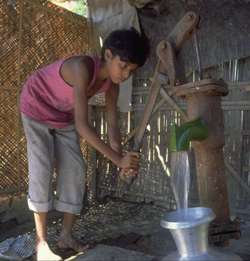
The citizens of Bangladesh have more reason than many to reflect that the road to hell is paved with good intentions, says Ian Randall*.
Geoscientist Online 24 May 2010
IIn the 1960s, drilling schemes were initiated in Bangladesh to exploit the supposedly clean, shallow aquifers of the Ganges Delta for water supplies, and so remove the threat of water-borne disease. Misfortune struck when it was found that, while bacterially clean, waters pumped from these wells were often contaminated with natural arsenic. Having affected the health of 70 million people for over three decades, a noble humanitarian effort turned into the largest case of mass poisoning in human history.
After a lengthy project to identify As-contaminated wells, attention turned to the country’s deeper aquifers as a source of clean water. Yet, as Nature Geoscience reported earlier this year1, a new study of the aquifer system has shown that even this salvation may bring risks were such resources to be over-used.
The arsenic of the Bengal Basin is found in grey, reducing Holocene deposits, often accompanied by a ferric oxyhydroxide coating. The region is underlain by Late Cretaceous rocks, above which many hundreds of metres of permeable fluvio-deltaic sediment have built up. Groundwater can be extracted from depths of up to 350m.
Arsenic is released by microbial reductive dissolution of this ferric oxyhydroxide coating – an effect increased by the presence of organic carbon. Concentrations of As in pore waters appear to depend on a number of factors, including the availability of organic carbon, groundwater flow and local sedimentology. Where reduction does not occur, and oxidized sediments that can absorb the arsenic are present, groundwater tends to be As-free. This is notable in Pleistocene (and older) sediments, and any younger deposits emplaced nearby. As a result, fewer than one per cent of wells deeper than 150m show significant concentrations of As.
The groundwater itself forms a hydraulically connected network of regional aquifers spanning most of the basin. Within this, the shallow aquifer is predominantly (but not wholly) separated from the deeper groundwaters by the presence of an impermeable silt-clay layer (known as an “aquitard”). This study, which analysed data from over 2000 deep boreholes, has shown that breaks in these aquitards become the focus of vertical flow, which might allow allow shallow waters to contaminate lower aquifers if pumping from these create a sufficiently high hydraulic gradient.